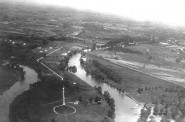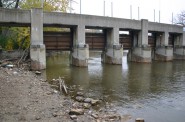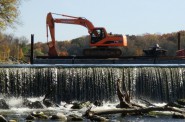Estabrook Dam’s Environmental Impact
Green activists support the dam’s removal, but that might actually hurt the environment.
Changes in Water Quality Parameters
Another general environmental claim is that removal of the Estabrook Dam will result in more favorable (i.e., “fish friendly”) conditions in terms of water temperature and oxygen levels. The interplay between channel geometry, water velocity, water depth, water temperature, photosynthetic activity, and oxygen levels is quite complex. Although I would anticipate that on balance there would be some net improvement in water quality if the dam is removed, there is no guarantee this will occur. For most dam removal projects, the river establishes a channel that is significantly narrower than the impoundment, helping somewhat to maintain water depths and to alleviate the effects of heating on what is typically a much shallower body of water. This typical change in channel morphology is demonstrated in before and after photos presented below of the impoundment for the Campbellsport Millpond Dam which was removed in 2011. But as is evident to anyone commuting south on I-43 over the past seven years and observing the Milwaukee River while passing Hampton Avenue, this type of narrowing of the channel has generally not occurred in the impoundment for the Estabrook Dam since the gates were opened in 2008. The channel in many locations is nearly the same width as the impoundment was when the gates were closed. Even with higher flow rates, the much shallower water depths (in particular, during summer months and periods of extreme low flow) that occur without the dam present the possibility that equal or greater temperature extremes could actually occur within this section of the Milwaukee River. In short, a repaired dam might actually realize less temperature extremes in the water.

Before and after photos of the Milwaukee River upstream from the Campbellsport Millpond Dam show the dramatic narrowing of the river channel after removal of the dam in 2011.
A case study presented as Chapter 8 in Dam Removal Research: Study and Prospects on the Good Hope Mill Dam on Conodoguinet Creek in Cumberland County, Pennsylvania, included data from continuous monitoring (at 15-minute intervals) for dissolved oxygen, temperature, pH, and specific conductance (or ability to flow) performed over a six month period extending before and after removal of the dam. Following removal of the dam, the study reported no change in the magnitude of the daily extremes for these water quality parameters – only a shift in the timing for when the extremes occurred. The mean annual flow rate for this river of 619 cfs is exactly equal to the mean summer flow calculated for 2008-14 for the Milwaukee River. The conditions observed at the Good Hope Mill Dam may not be typical, but clearly contradict the presumption that improvements in key water quality parameters will result from removal of the Estabrook Dam.
Fish Habitat
Attributing improvements in fish habitat to dam removal (beyond those that would result from repair of the dam in conjunction with construction of a fish passage) also appears to be a general assumption not supported by actual data. No surveys of fish populations appear to have been completed for this segment of the Milwaukee River since the gates were opened in 2008. However, several detailed fish surveys were completed by WDNR during 1996 through 2001 that included not only the impoundment but other nearby sections of the Milwaukee River. Some of the data from these surveys is summarized below.
| Summary of Select WDNR Fish Survey Data for the Milwaukee River (1996-2001) | ||||
| Fish Population Measure | Capitol Drive -former North Ave. Dam impoundment area (post-removal) | Lincoln Park – Estabrook Dam impoundment (pre-drawdown) | Kletzsch Park -downstream of dam | Brown Deer Road |
| Survey Years | 1996, 1997, 1998, 2000, 2001 | 2000, 2001 | 1996, 1998, 1999, 2000, 2001 | 1996, 1998 |
| Length of River Sampled | 1,850 m segment extending south from Capitol Drive Bridge | 5,400 m segment extending south from Bender Rd to near the dam | 460 m segment extending from base of dam to Bender Rd | 400 m segment extending downstream from Brown Deer Rd. |
| Total Individual Fish Captured | 6,267 | 468 | 1,867 | 272 |
| Total Fish Species | 41 | 24 | 32 | 17 |
| Index of Biotic Integrity (1) | 20 (Poor) in 1996; 57-62 (Good) in 1997-98; 70-80 (Excellent) in 1999-2001 | Not calculated by WDNR | 54 (Good) in 1996; 65-80 (Excellent) in 1998-2001 | Not calculated by WDNR |
| % Carp of Total Fish Surveyed | 0.5% | 7.1% | 0.6% | 2.9% |
| % Smallmouth Bass of Total Fish Surveyed | 37.6% | 12.8% | 15.4% | 14.0% |
| % Greater Redhorse of Total Fish Surveyed | 1.0% | 3.6% | 6.3% | 0.0% |
| Reference: Changing Habitat and Biodiversity of the Lower Milwaukee River and Estuary (WDNR Publication PUB-FH-511-2005). (1) As developed by Lyons (1992) for Wisconsin warm-water streams. | ||||
Different methods were reportedly used by WDNR for the surveys completed in different segments of the river. In addition, there were significant variations in the results from one year to the next at several locations. Therefore, it is difficult to draw conclusions from the data for the two survey locations that were sampled only on two years, including the Estabrook Dam impoundment. All of the surveys were performed following opening of the North Avenue Dam, but before the 2008 order to leave the gates open for Estabrook Dam.
One of the findings of the WDNR study that somewhat surprised me was that index of biotic integrity (a measure of ecological health) was characterized as excellent for both the section of the Milwaukee River in Kletzsch Park that is immediately upstream from the Estabrook Dam impoundment, and the section near Capitol Dr. that lies approximately one-half mile downstream of the impoundment. Thirty-two species of fish were observed in the Kletzsch Park segment of the River in 1996-2001. While the Estabrook Dam impoundment contained lesser numbers of fish and fish species, on several measures, it appeared to be comparable to the free-flowing segment of the Milwaukee River near Brown Deer Road. Although the highest percentage of carp (7.1 percent of the total fish surveyed) was reported for the Estabrook Dam segment of the River, all of the carp were observed during 2000 with none reported in a subsequent survey in 2001. Whereas carp are regarded as a fish species indicative of degraded habitat and lower water quality, the Estabrook Dam impoundment was also noteworthy in containing the second highest percentage population of Greater Redhorse, a state-listed threatened warm-water fish species that the environmental assessment considered to be “intolerant of degraded habitat.”
While it is possible that fish habitat and populations would improve with permanent removal of the dam, there are anecdotal reports from riverfront property owners (at least two of whom are members of the Milwaukee River Preservation Association, which favors the dam) as well as from Milwaukee Riverkeeper that fishing has decreased in quality within the former impoundment area since the gates were opened in 2008. Improvements in fish habitat and recreational fishing are one of the most important benefits cited in the EA and by Riverkeeper as a benefit from removing the dam, but the previous survey data as well as the anecdotal reports suggest these improvements may be limited, and almost certainly not analogous to improvements that occurred following removal of the North Avenue Dam.
In conclusion, many of the most important environmental benefits anticipated from dam removal appear to have limited supporting evidence. There is a possibility that no significant environmental benefits would result from removal of the dam beyond those which might occur with repair of the dam in conjunction with construction of a fish passage and implementation of improved operating protocols for the seasonal and other drawdowns. The possibility exists that in the short term (as the river reaches some type of equilibrium with maturing vegetation on 30 acres of former impoundment) that sedimentation issues might be exacerbated with removal of the dam. Temperature extremes could also be exacerbated during summer months if the dam is removed, due to the very shallow water depths that may develop. Whereas only eight species of fish were recorded in the North Avenue Dam impoundment prior to removal of the dam, at least 24 species of fish were present in the Estabrook Dam impoundment in 2000-01, seven or more years before the opening of the gates in 2008. The sections of the river immediately upstream and one-half mile downstream of the Estabrook Dam impoundment were rated as excellent long before the 2008 WDNR order to open the gates. Using the changes that occurred following the North Avenue Dam as an analogy for improvements that would occur in this segment of the river is probably unrealistic and inappropriate.
![Photograph of fish passing through the fish passage at the Mequon-Thiensville Dam. As of June 2015, a total of 35-species of fish have been recorded by a “fishcam” in the act of swimming past the dam [http://www.co.ozaukee.wi.us/1248/Fishway-Camera]).](https://urbanmilwaukee.com/wp-content/uploads/2016/01/image03.jpg)
Photograph of fish passing through the fish passage at the Mequon-Thiensville Dam. As of June 2015, a total of 35-species of fish have been recorded by a “fishcam” in the act of swimming past the dam [http://www.co.ozaukee.wi.us/1248/Fishway-Camera]).
Article Continues - Pages: 1 2
A Freshwater Controversy
-
The Path Forward for Estabrook Dam
 Feb 10th, 2016 by David Holmes
Feb 10th, 2016 by David Holmes
-
Does the Estabrook Dam Cause Flooding?
 Dec 30th, 2015 by David Holmes
Dec 30th, 2015 by David Holmes
-
Repairing Estabrook Dam Will Cost Less
 Dec 23rd, 2015 by David Holmes
Dec 23rd, 2015 by David Holmes






















Oh by the way, the dam is really ugly too.
I can’t understand the entire controversy given that the dam doors are open at all times so what is the difference if the structure stands or not? The dam also serves as a bridge to the cool island to the West and even thought it is nominally locked many fisherman and others climb over to get to the bridge. It certainly isn’t ugly and with a little enhancement it would be very attractive in its deco style. What is ugly is whatever the DNR or whoever did to the West bank last summer, cutting down hundreds of old stand trees and dredging and then reseeding and planting stick trees. That was shocking!
I’m curious about this series of articles, is this really journalism meant to inform or persuade? At first glance, this seems like a serious look at the issue but the series always concludes that money needs to be spent maintaining or rebuilding the dam.
Gems like this one:
“Temperature extremes could also be exacerbated during summer months if the dam is removed, due to the very shallow water depths that may develop.”
The water would be faster flowing and wouldn’t have nearly the same size area to gain heat from the sun… under what process would that increase the water temperature?
Tim,
From the onset the author said these articles were intended to persuade his view that removing the dam is not a good idea. To answer your mechanism question, in summer the river is very low and slow. Without the dam (see below) water levels upstream will be very much lower. Shallow water allows sunlight to reach the river bed and heat up the ground. This makes the water hotter. In other words a shallow pool is hotter than a deep one given the same surface area.
I’ve asked before and I’ll ask again. I wish the author would expound on the fish passage idea. The Thiensville photo is very interesting. I also still think people are confused about what “the dam” actually is. I know I was. The gates by themselves are not the dam. The dam is the entire built up wall running across the river. In fact you could remove the gate structure completely and the river would still be considered dammed – no “n” 😉
After reading this series of articles I no longer am in favor of removing the dam. In fact I now know I never was. All I want is to remove the ugly gate system and replace it with a falls that fish can pass. I’d love to see the winding, stepped dam be cleaned and restored for sitting and picnicking.
D’nardo
I didn’t realize that the gates were superfluous. Thanks D’nardo for this info. I think the dam can be modified for the fish passage and be re-formed to be a pleasant destination for all.
“In other words a shallow pool is hotter than a deep one given the same surface area.”
That’s my point, the total amount of flow is unchanged. The surface area is the variable, more surface area vs less. The large pooled area might be slightly deeper but itself is the collector of the sun’s heat that warms the water.
Less pooled area = less solar temp gain. If you don’t believe me, that’s fine, but I’m not the one talking about an alternate law of physics.
Tim,
You must have missed that day in physics class. You’re saying that a pool with 1 square mile of surface area will be the same temperature whether it’s 6″ deep or 6 miles deep. That’s incorrect.
The Milwaukee River is shallow. In late summer it’s really shallow – you can walk across it south of Capital. The Estabrook dam (either the ancient natural or the modern man-made) keeps the upstream pool area deep and less susceptible to summer warming. If we remove the dam (not just the gates), the upstream water will become shallower and hotter.
About flow: A dam (let’s say a natural dam) limits flow when the river levels are low. So in October a dam will prevent water from flowing but maintain the upstream pool. But that same dam has almost no effect during spring floods because all the water levels higher than the dam flow freely over it. You can’t talk about flow as a simple number. It doesn’t work that way.
I’m not a civil engineer, but I did pass my physics classes.
D’nardo
So if there is going to be no change in environmental conditions, why pay to rebuild it? Get rid of it. The thing people fail to recognize is that rebuilding it puts everyone on the hook for maintenance and risk for the foreseeable future. Additionally, the author claims that only 10 homes will be removed from the floodplain if the dam is demolished. Why are these 10 homeowners less important than the homeowners that surround the impoundment? Let’s be smart about our infrastructure. Just because it was built once doesn’t mean it MUST be replaced. Can we please match our resources to our footprint?
I regret that I disagree with the author that the removal of the North Ave Dam. was environmentally beneficial. Further, I suggest analysis of actual sediment transport which occurred will demonstrate that the North Ave. Dam removal effected the greatest ECOLOGICAL and ECONOMIC catastrophe in the history of SE Wisconsin since the 1875 typhoid epidemic. The method used by the WDNR to calculate the transport of highly contaminated and definitely cancer correlated river bottom soils produced an estimate of 3156 tons (ref Mar 21, 1991 WDNR letter to Milwaukee Mayor John Norquist) . The corrected theoretical calculations sent to the WDNR recently show over 419,000 tons were actually dumped into our estuary and our drinking water supplies in Lake Michigan . The hypothesis that this transport almost certainly caused the March 31,1993 cryptosporidium epidemic and the subsequent cladophera / e-coli algae blooms which virtually eliminated use of our Lake Michigan swimming beaches can now be evaluated by simply duplicating the Sediment Transport Section of the Woodward Clyde Study of 1994. If the 419,000 ton figure is correct, the taxpayers serviced by the Milwaukee Water Dept. have paid over $340 Million to redo the Texas Ave water intake and the Howard Ave Water Treatment Plant , plus an estimated $50 Million in legal costs for the crypto lawsuits, plus the collateral damages of loss of use of our beaches , plus the seasonal stench on near shore areas due to rotting algae , not to include the human misery caused to 400,000 people who lost wages, health and in over 54 cases, their lives. Such allegations I believe are significant enough to justify an investigation of the facts and a re evaluation by all of us regarding a history of insufficient foresight by dam removal advocates in this state.
D,
For the comparison of this summer day, between having an impoundment and not, there is no difference in the total flow in the river.
This is what turns the impoundment, even if it’s deeper, into a solar collector that warms the water. Since the area of the river gets wider, please remember that the flow volume of the river is unchanged, and thus causes the speed of the water to decrease.
So, you have the water covering more area becoming a larger solar collector and it’s in that state for a longer time, since the speed of that section of the river is slower.
I understand it’s counterintuitive that a shallow, running stream/river would be cooler than a relatively deeper impoundment but the depth is counteracted by the other factors.
Once again, skepticism is a good thing, but it might help to skim this.
https://www.google.com/url?sa=t&source=web&rct=j&url=http://www.michigandnr.com/PUBLICATIONS/PDFS/ifr/ifrlibra/research/reports/2058rr.pdf&ved=0ahUKEwiCw8e4-LXKAhULvYMKHVLRAI4QFgggMAI&usg=AFQjCNEQtVdzTDTnpayL84pGF2jSyGvclQ&sig2=5p-43Uj5osJHXHlclIUttQ
For a comprehensive counter argument to Mr. Holmes please follow this link.
https://static1.squarespace.com/static/55157271e4b0179c6ec8b662/t/56e342154c2f8502d979d2aa/1457734177488/EstabrookDam_ver_FINAL+03112016.pdf
For a brief summary of the comprehensive counter argument to Mr. Holmes please follow these two links.
http://urbanmilwaukee.com/2016/03/15/op-ed-dont-repair-the-estabrook-dam/
http://urbanmilwaukee.com/2016/03/22/op-ed-questions-and-answers-on-estabrook-dam/
dick yahr, are you suggesting that the removal of the North Avenue dam in 1997 somehow caused the cryptosporidium outbreak in 1993?